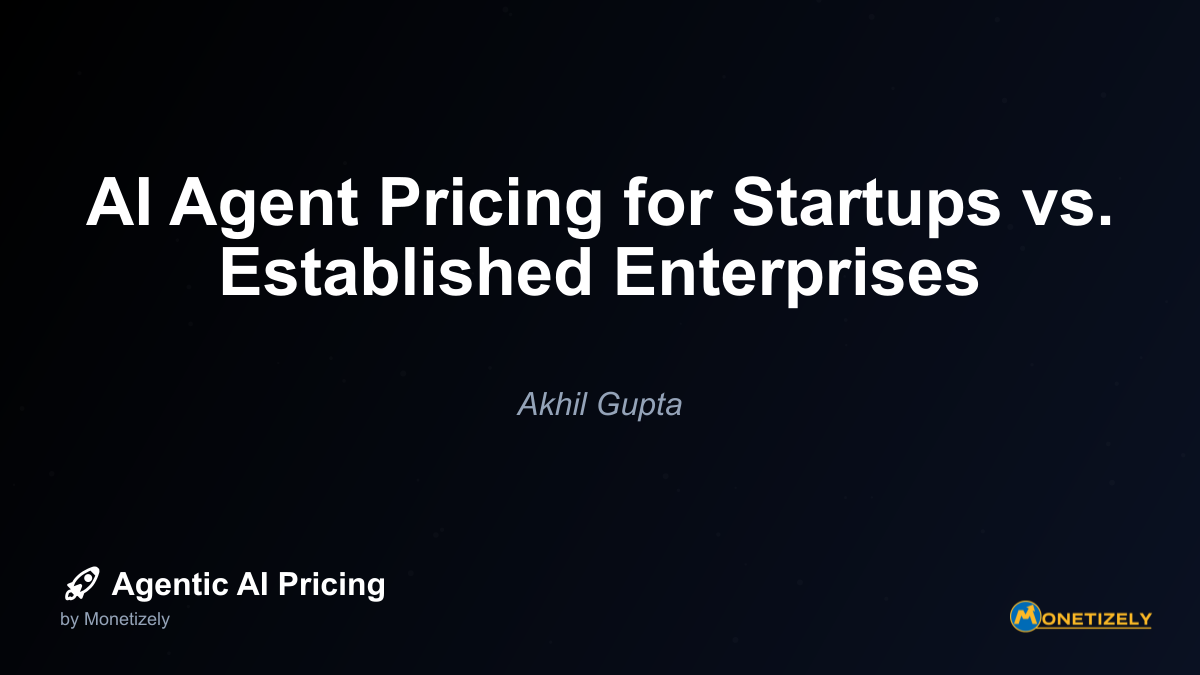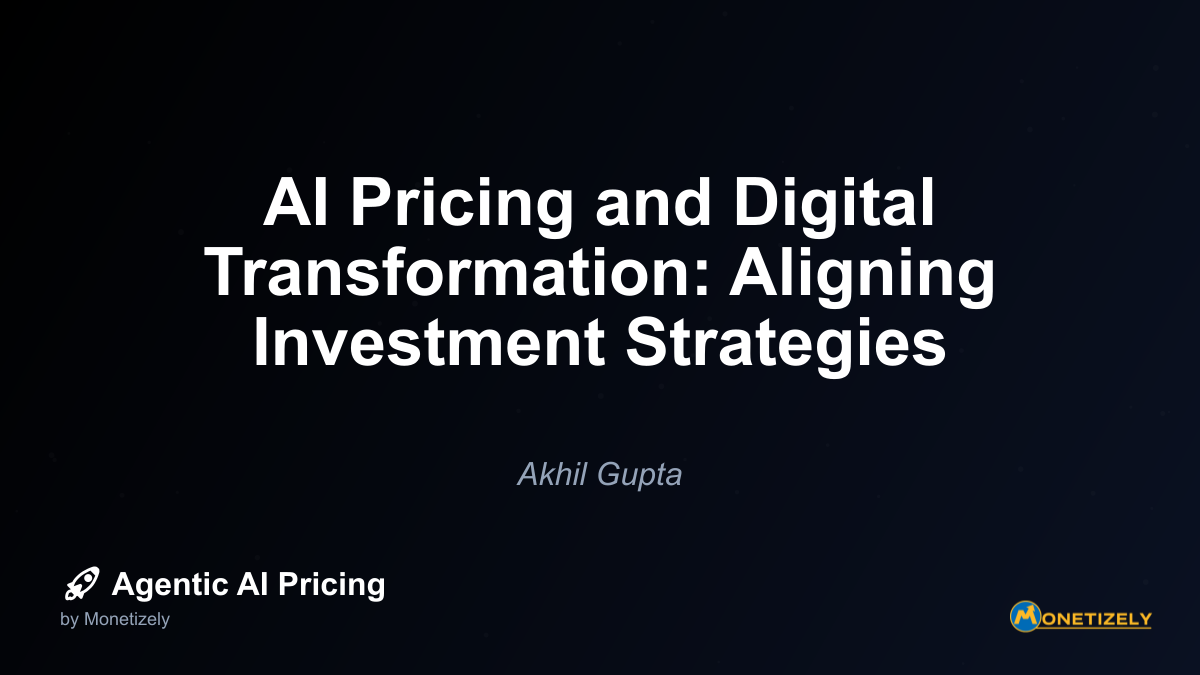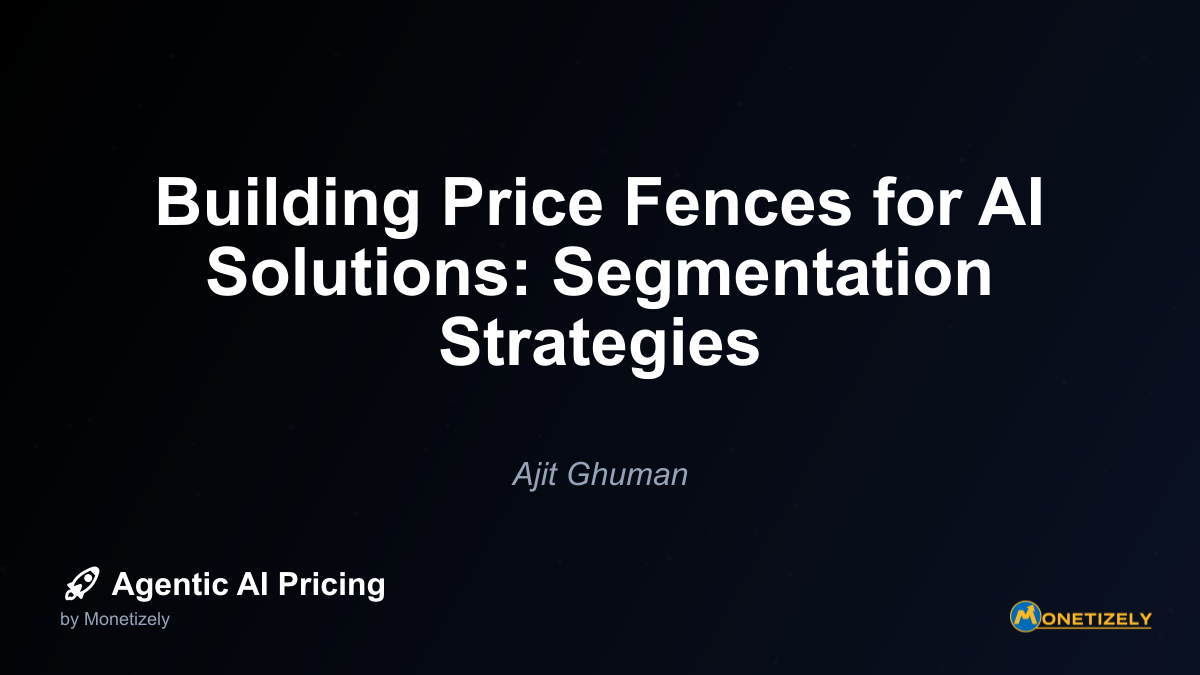· Akhil Gupta · Strategy · 8 min read
AI Agent Pricing for Startups vs. Established Enterprises
AI and SaaS Pricing Masterclass
Learn the art of strategic pricing directly from industry experts. Our comprehensive course provides frameworks and methodologies for optimizing your pricing strategy in the evolving AI landscape. Earn a professional certification that can be imported directly to your LinkedIn profile.

Enterprises can also bundle AI agent capabilities with existing products and services. This approach leverages established customer relationships and creates natural upsell paths. Google’s integration of Gemini features across its Google Workspace suite exemplifies this strategy, where AI capabilities become value-enhancers for existing product lines rather than standalone offerings.
Enterprise pricing strategies often blend subscription and usage-based components to maximize predictable revenue while accommodating variable usage patterns. This hybrid approach provides financial predictability for both the enterprise and its customers.
Enterprise-Grade Pricing Structures
Established enterprises typically implement more sophisticated pricing structures that address the complex needs of large organizations:
Tiered Enterprise Licensing
Most enterprise AI providers offer multi-tiered pricing with graduated access to features, usage limits, and support levels. These tiers often include:
- Standard/Professional: Core AI agent capabilities with moderate usage limits
- Business/Team: Enhanced features and administrative controls for departmental use
- Enterprise: Custom contracts with negotiated terms, dedicated support, and SLAs
This tiered approach allows enterprises to capture value across different customer segments while providing clear upgrade paths as usage and needs expand.
Value-Based Pricing Components
Enterprises increasingly incorporate value-based elements into their AI agent pricing, particularly for solutions that deliver measurable business outcomes.
Salesforce’s Einstein AI pricing exemplifies this approach by connecting costs to the value delivered through increased sales, improved customer retention, or operational efficiencies. By aligning pricing with customer success metrics, enterprises can justify premium rates while strengthening the business case for adoption.
Leveraging Existing Customer Relationships
Perhaps the greatest pricing advantage for established enterprises is their ability to monetize existing customer relationships:
- Cross-selling AI capabilities to current customers with established trust
- Bundling AI agents with core products to increase overall solution value
- Creating AI-enhanced premium tiers of existing products
This approach minimizes customer acquisition costs and leverages established procurement relationships, significantly reducing go-to-market friction compared to startups.
“Enterprises should view AI agent pricing as an extension of their existing value proposition,” advises enterprise pricing consultant Michael Chen. “The most successful enterprise AI monetization strategies build upon established customer relationships rather than creating entirely new value narratives.”
Convergence and Evolution: How Pricing Strategies Change as Companies Mature
As AI startups grow and evolve, their pricing strategies typically transition toward enterprise approaches. This evolution reveals important patterns about the maturation of AI agent pricing:
The Startup-to-Enterprise Pricing Evolution
Successful AI startups often follow a predictable pricing evolution:
- Initial phase: Simple, often usage-based pricing with generous free tiers to drive adoption
- Growth phase: Introduction of tiered plans with differentiated feature sets and usage limits
- Expansion phase: Development of enterprise offerings with custom contracts
- Maturity phase: Sophisticated value-based pricing with industry-specific solutions
This evolution reflects the changing priorities as startups gain market traction, build brand equity, and develop more complex product offerings.
Case Study: OpenAI’s pricing evolution exemplifies this transition. Starting with simple API access pricing, they progressed to tiered models for ChatGPT, introduced enterprise contracts, and eventually developed industry-specific solutions with custom pricing.
Balancing Growth and Profitability Across the Maturity Spectrum
Both startups and enterprises must balance growth objectives with profitability requirements, but their approaches differ substantially:
Startups: Growth-Oriented Pricing
Early-stage AI startups typically prioritize user acquisition and market penetration over immediate profitability. Their pricing strategies often include:
- Lower initial price points to reduce adoption barriers
- Generous free tiers to maximize user acquisition
- Simple pricing structures to minimize friction
- Rapid iteration based on market feedback
While this approach sacrifices short-term revenue optimization, it accelerates market penetration and data collection—both crucial for AI agent improvement.
Enterprises: Profitability-Oriented Pricing
Established enterprises typically emphasize sustainable margins and predictable revenue growth in their AI agent pricing. Their strategies often include:
- Premium positioning based on reliability and trust
- Complex pricing structures that optimize value capture
- Slower iteration cycles with extensive market testing
- Emphasis on long-term customer lifetime value
This approach prioritizes predictable revenue streams and profit contribution over rapid market share acquisition.
“The fundamental tension in AI agent pricing is between capturing immediate value and building long-term market position,” notes pricing researcher Dr. Alisha Patel. “Startups and enterprises resolve this tension differently based on their financial constraints and strategic objectives.”
Practical Implementation: Tailoring AI Agent Pricing to Company Maturity
How should companies implement pricing strategies appropriate to their maturity level? The following frameworks provide practical guidance:
For Startups: The Progressive Value Capture Framework
AI startups can implement a progressive value capture approach that evolves as their market position strengthens:
Validation Stage
- Offer limited free access to core capabilities
- Implement simple usage-based pricing for advanced features
- Focus on minimizing friction in initial adoption
- Collect usage data to inform future pricing optimization
Traction Stage
- Introduce tiered pricing with clear value differentiation
- Maintain free tier but with strategic limitations
- Begin developing enterprise offerings for early adopters
- Test price sensitivity across customer segments
Expansion Stage
- Implement segment-specific pricing strategies
- Develop custom enterprise contracts with negotiated terms
- Begin shifting toward value-based pricing components
- Create partner-friendly pricing for ecosystem expansion
This progressive approach allows startups to capture increasing value as their market position strengthens while maintaining growth momentum.
For Enterprises: The Value-Maximization Framework
Established enterprises can implement a value-maximization approach that leverages their existing advantages:
Integration Strategy
- Bundle AI agent capabilities with existing products
- Create AI-enhanced premium tiers for current offerings
- Develop cross-selling pathways for existing customers
- Align pricing with established product value metrics
Differentiation Strategy
- Emphasize enterprise-grade security, compliance, and reliability
- Develop industry-specific AI agent solutions with premium pricing
- Implement outcome-based pricing components where measurable
- Create comprehensive solution packages beyond core AI capabilities
Ecosystem Strategy
- Develop platform pricing that encourages ecosystem development
- Create partner-friendly pricing models that expand solution scope
- Implement pricing that drives data network effects
- Design multi-product bundles that increase switching costs
This value-maximization approach allows enterprises to leverage their existing advantages while creating sustainable competitive moats around their AI agent offerings.
Market Position Considerations: Beyond Company Size
While company maturity significantly influences AI agent pricing strategy, market position within specific sectors introduces additional considerations:
Industry Leadership Premium
Companies with established leadership positions in specific industries can command premium pricing for industry-specific AI agents, regardless of overall company size.
Vertical AI startups targeting specific industries can sometimes implement enterprise-like pricing despite their small size, particularly when they offer specialized capabilities with clear ROI. Companies like Viable (customer feedback AI) and Harvey (legal AI) successfully implement premium pricing despite being relatively young companies.
First-Mover Advantages in Pricing
First movers in emerging AI agent categories often have greater pricing flexibility until competitive alternatives emerge.
Early entrants can establish price anchors that shape market expectations, potentially setting higher reference prices than would be possible in mature markets. This advantage exists for both startups and enterprises but requires careful balance—pricing too high can slow adoption and invite competition, while pricing too low can undervalue the solution and leave money on the table.
Competitive Intensity Factors
The competitive landscape within specific AI agent categories significantly impacts pricing freedom for both startups and enterprises.
In highly competitive categories with multiple similar offerings, price becomes a more significant differentiator, potentially forcing both startups and enterprises toward the lower end of their viable pricing range. Conversely, in categories with limited alternatives, both company types can implement more aggressive value-based pricing.
Key Pricing Metrics Across the Maturity Spectrum
Startups and enterprises typically prioritize different metrics when evaluating AI agent pricing performance:
Startup-Focused Metrics
Early-stage AI companies typically emphasize:
- User acquisition cost relative to lifetime value
- Conversion rates from free to paid tiers
- Monthly recurring revenue growth rates
- Cash burn relative to customer acquisition
- Expansion revenue from existing customers
These metrics reflect startups’ focus on growth, capital efficiency, and path to sustainable economics.
Enterprise-Focused Metrics
Established enterprises typically prioritize:
- Revenue per customer and account expansion
- Profit contribution by product and segment
- Competitive win rates at different price points
- Renewal rates and customer lifetime value
- Bundle attachment rates for AI capabilities
These metrics reflect enterprises’ emphasis on profitability, competitive position, and long-term customer relationships.
Both company types should track price realization (actual revenue captured vs. list price) and willingness-to-pay across customer segments, but their primary focus areas naturally differ based on their strategic objectives.
Conclusion: Aligning Pricing Strategy with Company Reality
The optimal AI agent pricing strategy must align with a company’s market position, financial realities, and strategic objectives. While no universal approach works for all organizations, certain principles apply across the maturity spectrum:
- Value demonstration is essential for AI agents regardless of company size
- Pricing complexity should increase with product sophistication and market education
- Data network effects should influence pricing strategy as usage scales
- Customer acquisition costs must be factored into sustainable pricing models
For startups, the priority is typically establishing market traction while extending runway—suggesting pricing strategies that reduce adoption friction while generating sufficient cash flow to sustain operations. Progressive value capture approaches that evolve with market position typically serve startups best.
For enterprises, the focus usually centers on maximizing value capture from existing relationships while building sustainable competitive advantages. Value-maximization approaches that leverage brand equity, existing customer relationships, and solution completeness typically yield the best results.
As the AI agent market continues maturing, we’ll likely see further convergence of pricing strategies, with successful startups adopting more enterprise-like approaches and innovative enterprises implementing startup-inspired pricing components. The companies that will thrive are those that align their pricing strategy not just with market standards but with their unique position in the evolving AI landscape.
By understanding the distinct pricing challenges and opportunities at different maturity levels, companies can develop AI agent monetization strategies that support both immediate objectives and long-term competitive positioning. In the rapidly evolving AI landscape, pricing strategy remains one of the most powerful yet underutilized levers for sustainable success.
Co-Founder & COO
Akhil is an Engineering leader with over 16+ years of experience in building, managing and scaling web-scale, high throughput enterprise applications and teams. He has worked with and led technology teams at FabAlley, BuildSupply and Healthians. He is a graduate from Delhi College of Engineering and UC Berkeley certified CTO.
Pricing Strategy Audit
Let our experts analyze your current pricing strategy and identify opportunities for improvement. Our data-driven assessment will help you unlock untapped revenue potential and optimize your AI pricing approach.




